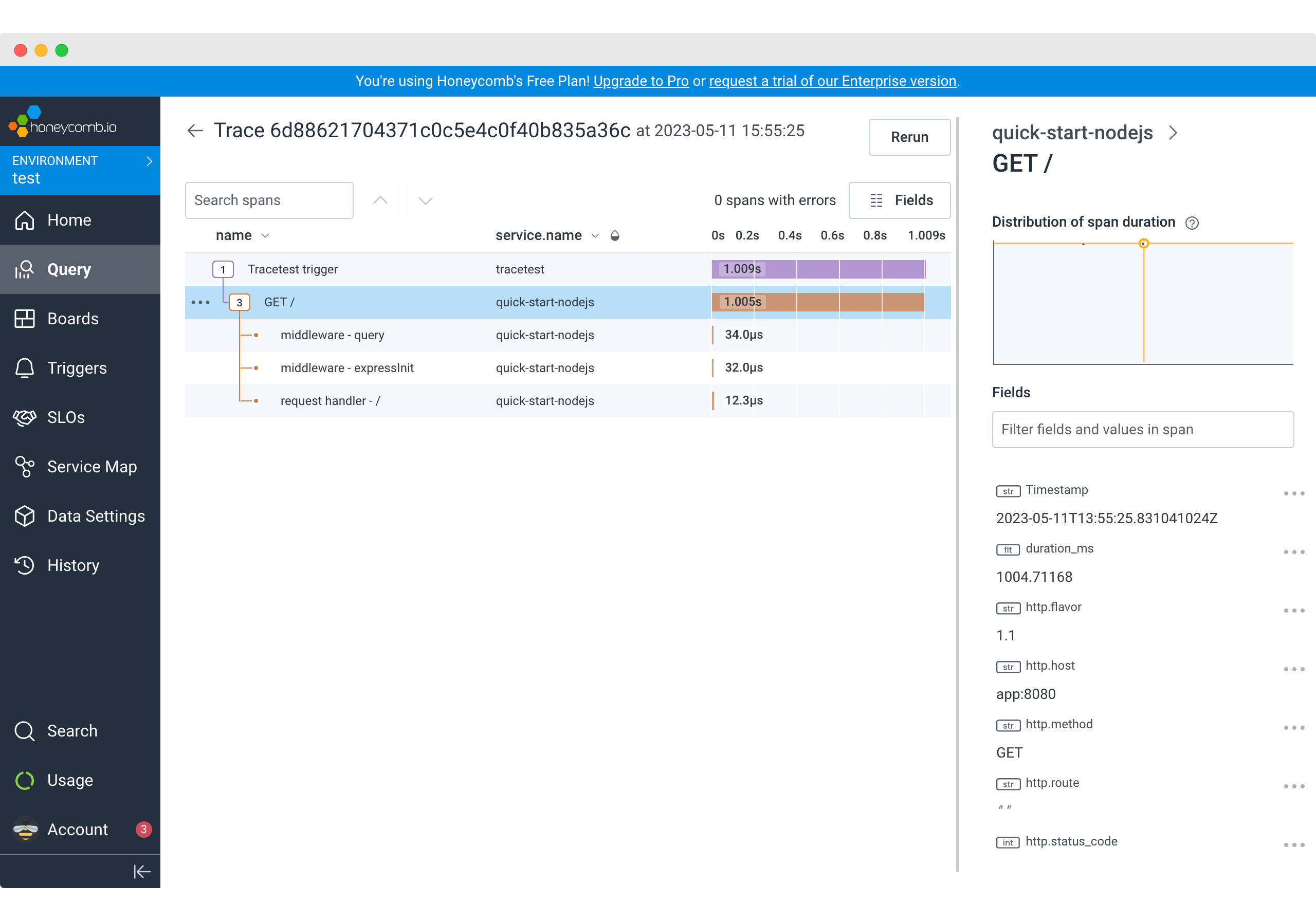Node.js and Honeycomb
Tracetest is a testing tool based on OpenTelemetry that allows you to test your distributed application. It allows you to use data from distributed traces generated by OpenTelemetry to validate and assert if your application has the desired behavior defined by your test definitions.
Honeycomb is an observability solution that shows you the patterns and outliers of how users experience your code in complex and unpredictable environments.
Node.js App with Honeycomb, OpenTelemetry and Tracetest
This is a quick start on how to configure a Node.js app to use OpenTelemetry instrumentation with traces, and Tracetest for enhancing your E2E and integration tests with trace-based testing and Honeycomb as a trace data store.
Prerequisites
Tracetest Account:
- Sign up to
app.tracetest.ioor follow the get started docs. - Have access to the environment's agent API key.
Docker: Have Docker and Docker Compose installed on your machine.
Run This Quckstart Example
The example below is provided as part of the Tracetest project. You can download and run the example by following these steps:
Clone the Tracetest project and go to the Node.js Quickstart:
git clone https://github.com/kubeshop/tracetest
cd tracetest/examples/tracetest-honeycomb
Follow these instructions to run the quick start:
- Copy the
.env.templatefile to.env. - Fill out the TRACETEST_TOKEN and ENVIRONMENT_ID details by editing your
.envfile. - Fill out the HONEYCOMB_API_KEY details by editing your
.envfile. - Run
docker compose run tracetest-run. - Follow the links in the output to view the test results.
Follow along with the sections below for a detailed breakdown of what the example you just ran did and how it works.
Project Structure
The quick start Node.js project is built with Docker Compose and contains the Tracetest Agent and a Node.js app.
The docker-compose.agent.yaml file in the root directory of the quick start runs the Node.js app and the Tracetest Agent setup.
Configuring the Node.js App
The Node.js app is a simple Express app, contained in the app.js file.
Configure the .env like shown below.
# Get the required information here: https://app.tracetest.io/retrieve-token
TRACETEST_TOKEN="<YOUR_TRACETEST_TOKEN>"
TRACETEST_ENVIRONMENT_ID="<YOUR_TRACETEST_ENVIRONMENT_ID>"
HONEYCOMB_API_KEY="<YOUR_HONEYCOMB_API_KEY>"
The OpenTelemetry tracing is contained in the tracing.otel.grpc.js or tracing.otel.http.js files. Traces will be sent to Tracetest Agent.
Choosing the tracing.otel.grpc.js file will send traces to Tracetest Agent's GRPC endpoint.
Enabling the tracer is done by preloading the trace file. As seen in the package.json.
"scripts": {
"app-with-grpc-tracer": "node -r ./tracing.otel.grpc.js app.js",
},
Run the Node.js App and Tracetest
To execute the tests, run this command:
docker compose run tracetest-run
This will:
- Start the Node.js app, the OpenTelemetry Collector, and send the traces to Honeycomb.
- Start the Tracetest Agent.
- Configure the tracing backend and create tests in your environment.
- Run the tests.
The output of the test will look similar to this:
Configuring Tracetest
SUCCESS Successfully configured Tracetest CLI
Running Trace-Based Tests...
✘ RunGroup: #VnMxUljSg (https://app.tracetest.io/organizations/xxx/environments/xxx/run/VnMxUljSg)
Summary: 0 passed, 1 failed, 0 pending
✘ Test API (https://app.tracetest.io/organizations/xxx/environments/xxx/test/W656Q0c4g/run/1/test) - trace id: 9d33bbecf956d66b3b277d12e9ca4d3c
✘ span[tracetest.span.type="http" name="GET /" http.target="/" http.method="GET"]
✘ #94880e7cd465bd33
✔ attr:http.status_code = 200 (200)
✘ attr:tracetest.span.duration < 500ms (1s) (https://app.tracetest.io/organizations/xxx/environments/xxx/test/W656Q0c4g/run/1/test?selectedAssertion=0&selectedSpan=94880e7cd465bd33)
✘ Required gates
✘ test-specs
View Trace Spans Over Time in Honeycomb
To access a historical overview of all the trace spans the Node.js app generates, jump over to your Honeycomb account. With Honeycomb and Tracetest, you get the best of both worlds. You can run trace-based tests and automate running E2E and integration tests against real trace data. And, use Honeycomb to get a historical overview of all traces your distributed application generates.

Learn More
Feel free to check out our examples in GitHub and join our Slack Community for more info!